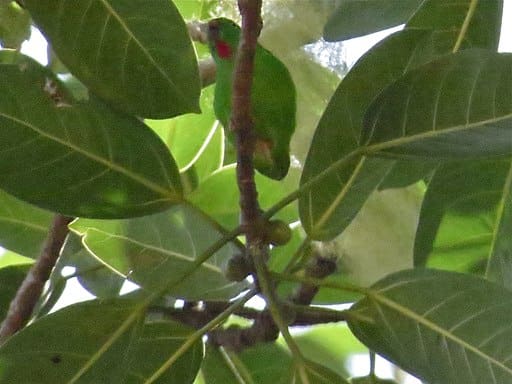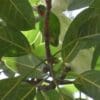Flores Hanging Parrot
Also known as:
Wallace's Hanging Parrot
Also known as:
Wallace's Hanging Parrot

Loriculus

flosculus
Size:
12 cm (4.7 in)
Weight:
Not recorded.
Subspecies including nominate:
one
Colour Adult:
Male-mainly green in colour, orange tint on nape to upper mantle; red rump and upper tail coverts; long, red mark on throat; green tail tipped with pale green; outer tail feathers tipped with orange/red. Beak orange/red. Eye orange. Female-as in male, but long, red mark on throat minimal or absent. Eye brown.
Colour Juvenile:
As in adult female, but beak duller in colour.
Call:
Calls made in flight are sharp and screeching; same notes are made while perched but are softer. Also emits some hoarse, abrupt notes in display.
More Information:
Content Sources:
CITES
BirdLife International
Cornell Lab of Ornithology/Birds of the World
Parrots: A Guide to Parrots of the World, Juniper and Parr, 1998
Parrots of the World, Forshaw, 2006. 2010 edition
Vanished and Vanishing Parrots, Forshaw, 2017.
Lexicon of Parrots, Thomas Arndt.
Parrots in Aviculture, Low, 1992.
Captive Status:
Rare
Longevity:
—
Housing:
Aviary 2 x 1 x 2 m (6.5 x 3.3 x 6.5 ft) or large bird-room cage with tiled surround and well-drained floor.
Diet:
Fruits such as: figs, apple, pear, banana, orange, pomegranate, mango, papaya, cactus fruits; vegetables such as: carrot, celery, green beans and peas in the pod; nectar made from: lactose-free baby cereal, honey, malt extract or molasses, mixed with filtered water and made fresh once or twice daily or, commercial lory nectar; various millet seed mixes, canary grass seed, and small amount of niger and oats (may be sprouted); millet spray (may be sprouted); softened rusk, eggfood and mealworm larvae for rearing.
Enrichment:
Enjoys bathing so provide overhead misters or shallow water bowls. Provide regular supply of fresh, unsprayed flowering, willow, or elder branches for the birds to remove the bark.
Nest Box Size:
—
Clutch Size:
Not recorded.
Fledging Age:
—
Hatch Weight:
—
Peak Weight:
—
Weaning Weight:
—
World Population:
2500-10,000 mature individuals, decreasing.
IUCN Red List Status:
Vulnerable
CITES Listing:
Appendix II
Threat Summary:
A BirdLife “restricted-range” species. Is threatened by the combined impacts of firewood collection, construction timber extraction and clearance for agriculture. Illegal logging continues even in areas that receive protection, as there is virtually no government enforcement of laws. Forest loss of 4% has occurred over three generations (13.2 years) with the assumption that it has continued at the same rate to the present day. Population changes may be proportional to forest cover change. Hence, the species is thought to decline at a rate of <10% over three generations.
Range:
Flores and Rinca Islands, Lesser Sundas, Indonesia.
Habitat:
Found from 450-1000 m (1312-3280 ft) in primary semi-evergreen forest. On Rinca seen in coastal moist deciduous forest. Apparently requires an abundance of fruiting figs.
Wild Diet:
Feeds on figs, fruits, nectar, buds and flowers.
Ecology and Behaviour:
Outside the breeding season birds gather in flocks of up to 20 individuals. Are easily overlooked in the canopy; noisy and conspicuous in flight.
Clutch and Egg Size:
Not recorded.
Breeding Season:
On Rinca nesting seen mid-April.

